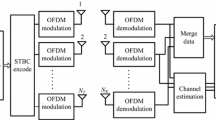Abstract
The inherent characteristic of hybrid carrier (HC) scheme based on the weighted-type fractional Fourier transform (WFRFT) is revealed. The proposed linear combination of single carrier (SC) and multicarrier’s (MC) characteristics is helpful to balance the conflicting requirements and achieve the comparative analysis of SC/MC. As an example, analytical SER/BER expressions of HC system with zero forcing (ZF) and minimum mean square error (MMSE) equalization are derived. In addition, the derived BER expressions are extended to multi-input systems. A unified framework of space time block code (STBC) HC scheme is proposed with two WFRFT modules at the transmitter or receiver, where STBC-SC and STBC-MC systems are the special cases of the novel structure.
Similar content being viewed by others
References
Ge X H, Chen J Q, Wang C X, et al. 5G green cellular networks considering power allocation schemes. Sci China Inf Sci, 2016, 59: 022308
Ge X H, Yang J, Gharavi H, et al. Energy efficiency challenges of 5G small cell networks. IEEE Commun Maga, 2017, 55: 184–191
Zhou S, Zhao T, Niu Z S, et al. Software-defined hyper-cellular architecture for green and elastic wireless access. IEEE Commun Maga, 2016, 54: 12–19
Li Y, Ngebani I, Xia X G, et al. On performance of vector OFDM with linear receivers. IEEE Trans Signal Process, 2012, 60: 5268–5280
Michailow N, Matthe M, Gaspar I, et al. Generalized frequency division multiplexing for 5th generation cellular networks. IEEE Trans Commun, 2014, 62: 3045–3061
Han S, Sung Y, Lee Y H. Filter design for generalized frequency-division multiplexing. IEEE Trans Signal Process, 2017, 65: 1644–1659
Wild T, Schaich F, Chen Y. 5G air interface design based on universal filtered (UF-)OFDM. In: Proceedings of International Conference on Digital Signal Processing, Hong Kong, 2014. 699–704
Huan H, Shi P F, Yan X D, et al. Generalized spatial representation for digital modulation and its potential application. Sci China Inf Sci, 2016, 59: 122303
Kang X, Tao R, Zhang F. Multiple-parameter discrete fractional transform and its applications. IEEE Trans Signal Process, 2016, 64: 3402–3417
Ibars C, Kumar U, Niu H, et al. A comparison of waveform candidates for 5G millimeter wave systems. In: Proceedings of the 49th Asilomar Conference on Signals, Systems and Computers, Pacific Grove, 2015. 1747–1751
Khansefid A, Minn H, Zhan Q, et al. Waveform parameter design and comparisons for millimeter-wave massive MIMO systems with RF distortions. In: Proceedings of IEEE Globecom Workshops, Washington, 2016. 1–6
Mei L, Sha X J, Ran Q W, et al. Research on the application of 4-weighted fractional fourier transform in communication system. Sci China Inf Sci, 2010, 53: 1251–1260
Mei L, Zhang Q Y, Sha X J, et al. WFRFT precoding for narrowband interference suppression in DFT-based block transmission systems. IEEE Commun Lett, 2013, 17: 1916–1919
Hui Y, Li B, Tong Z. 4-weighted fractional Fourier transform over doubly selective channels and optimal order selecting algorithm. Electron Lett, 2015, 51: 177–179
Wang Z D, Mei L, Wang X L, et al. Bit error rate analysis of generalised frequency division multiplexing with weighted-type fractional Fourier transform precoding. IET Commun, 2017, 11: 916–924
Lin Y P, Phoong S M. BER minimized OFDM systems with channel independent precoders. IEEE Trans Signal Process, 2003, 51: 2369–2380
Ohno S. Performance of single-carrier block transmissions over multipath fading channels with linear equalization. IEEE Trans Signal Process, 2006, 54: 3678–3687
Sanchez-sanchez J J, Fernandez-plazaola U, Aguayo-torres M C. BER analysis for SC-FDMA over rayleigh fading channels. In: Proceedings of International Conference on Broadband and Biomedical Communication, Melbourne, 2011. 43–47
Daoud S, Ghrayeb A. Using resampling to combat doppler scaling in UWA channels with single-carrier modulation and frequency-domain equalization. IEEE Trans Veh Tech, 2016, 65: 1261–1270
Kong D J, Xiang X G, Jiang T. An Alamouti coded CP-FBMC-MIMO system with two transmit antennas. Sci China Inf Sci, 2015, 58: 102306
Feng W, Wang Y, Ge N, et al. Virtual MIMO in multi-cell distributed antenna systems: coordinated transmissions with large-scale CSIT. IEEE J Sel Area Commun, 2013, 31: 2067–2081
Kan H B, Liu X D, Han G Y. On the criteria for designing complex orthogonal space-time block codes. Sci China Inf Sci, 2016, 59: 082303
Al-Dhahir N. Single-carrier frequency-domain equalization for space-time block-coded transmissions over frequencyselective fading channels. IEEE Commun Lett, 2001, 5: 304–306
Chung Y H, Phoong S M. Unitary precoders for ST-OFDM systems using Alamouti STBC. IEEE Trans Circ Syst I, 2008, 55: 2860–2869
Yoshizawa R, Ochiai H. Energy efficiency improvement of coded OFDM systems based on PAPR reduction. IEEE Syst J, 2017, 11: 717–728
Li C G, Li Y S, Song K, et al. Energy efficient design for multiuser downlink energy and uplink information transfer in 5G. Sci China Inf Sci, 2016, 59: 022305
Zhang Y H, Cui Q M, Wang N, et al. Energy-efficient resource allocation for hybrid bursty services in multi-relay OFDM networks. Sci China Inf Sci, 2017, 60: 102304
Hu H, Zhang H, Liang Y C. On the spectrum-and energy-efficiency tradeoff in cognitive radio networks. IEEE Trans Commun, 2016, 64: 490–501
Zhao L, Li K, Zheng K, et al. An analysis of the tradeoff between the energy and spectrum efficiencies in an uplink massive MIMO-OFDM system. IEEE Trans Circ Syst II, 2015, 62: 291–295
Acknowledgements
This work was supported by National Natural Science Foundation of China (Grant No. 61671179), National Basic Research Program of China (Grant No. 2013CB329003), and Science and Technology on Information Transmission and Dissemination in Communication Networks Laboratory (Grant No. EX156410046).
Author information
Authors and Affiliations
Corresponding author
Rights and permissions
About this article
Cite this article
Wang, Z., Mei, L., Sha, X. et al. BER analysis of STBC hybrid carrier system based on WFRFT with frequency domain equalization. Sci. China Inf. Sci. 61, 082301 (2018). https://doi.org/10.1007/s11432-017-9259-0
Received:
Revised:
Accepted:
Published:
DOI: https://doi.org/10.1007/s11432-017-9259-0




